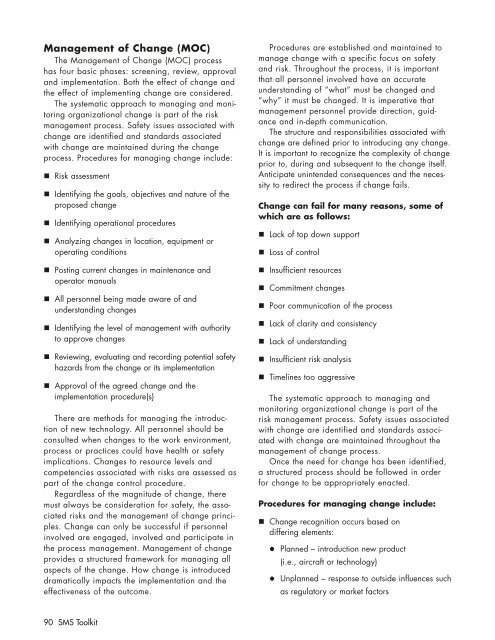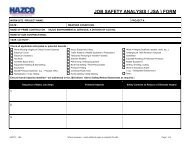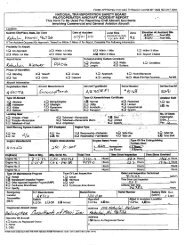International Helicopter Safety Team Safety Management System Toolkit
IHST - Safety Management Toolkit - Skybrary
IHST - Safety Management Toolkit - Skybrary
- No tags were found...
Create successful ePaper yourself
Turn your PDF publications into a flip-book with our unique Google optimized e-Paper software.
<strong>Management</strong> of Change (MOC)<br />
The <strong>Management</strong> of Change (MOC) process<br />
has four basic phases: screening, review, approval<br />
and implementation. Both the effect of change and<br />
the effect of implementing change are considered.<br />
The systematic approach to managing and monitoring<br />
organizational change is part of the risk<br />
management process. <strong>Safety</strong> issues associated with<br />
change are identified and standards associated<br />
with change are maintained during the change<br />
process. Procedures for managing change include:<br />
Risk assessment<br />
Identifying the goals, objectives and nature of the<br />
proposed change<br />
Identifying operational procedures<br />
Analyzing changes in location, equipment or<br />
operating conditions<br />
Posting current changes in maintenance and<br />
operator manuals<br />
All personnel being made aware of and<br />
understanding changes<br />
Identifying the level of management with authority<br />
to approve changes<br />
Reviewing, evaluating and recording potential safety<br />
hazards from the change or its implementation<br />
Approval of the agreed change and the<br />
implementation procedure(s)<br />
There are methods for managing the introduction<br />
of new technology. All personnel should be<br />
consulted when changes to the work environment,<br />
process or practices could have health or safety<br />
implications. Changes to resource levels and<br />
competencies associated with risks are assessed as<br />
part of the change control procedure.<br />
Regardless of the magnitude of change, there<br />
must always be consideration for safety, the associated<br />
risks and the management of change principles.<br />
Change can only be successful if personnel<br />
involved are engaged, involved and participate in<br />
the process management. <strong>Management</strong> of change<br />
provides a structured framework for managing all<br />
aspects of the change. How change is introduced<br />
dramatically impacts the implementation and the<br />
effectiveness of the outcome.<br />
Procedures are established and maintained to<br />
manage change with a specific focus on safety<br />
and risk. Throughout the process, it is important<br />
that all personnel involved have an accurate<br />
understanding of “what” must be changed and<br />
“why” it must be changed. It is imperative that<br />
management personnel provide direction, guidance<br />
and in-depth communication.<br />
The structure and responsibilities associated with<br />
change are defined prior to introducing any change.<br />
It is important to recognize the complexity of change<br />
prior to, during and subsequent to the change itself.<br />
Anticipate unintended consequences and the necessity<br />
to redirect the process if change fails.<br />
Change can fail for many reasons, some of<br />
which are as follows:<br />
Lack of top down support<br />
Loss of control<br />
Insufficient resources<br />
Commitment changes<br />
Poor communication of the process<br />
Lack of clarity and consistency<br />
Lack of understanding<br />
Insufficient risk analysis<br />
Timelines too aggressive<br />
The systematic approach to managing and<br />
monitoring organizational change is part of the<br />
risk management process. <strong>Safety</strong> issues associated<br />
with change are identified and standards associated<br />
with change are maintained throughout the<br />
management of change process.<br />
Once the need for change has been identified,<br />
a structured process should be followed in order<br />
for change to be appropriately enacted.<br />
Procedures for managing change include:<br />
Change recognition occurs based on<br />
differing elements:<br />
<br />
<br />
Planned – introduction new product<br />
(i.e., aircraft or technology)<br />
Unplanned – response to outside influences such<br />
as regulatory or market factors<br />
90 SMS <strong>Toolkit</strong>







